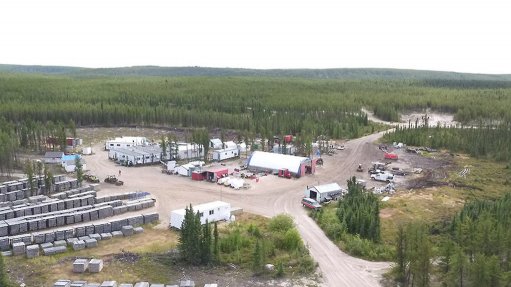
The Wheeler River camp in Canada.
Uranium company Denison Mines has selected the low-cost, in-situ recovery (ISR) mining method for the development of the high-grade Phoenix deposit at the Wheeler River project, marking the first deposit identified for ISR mining in Canada’s Athabasca basin.
The company decided on ISR mining following the evaluation of 32 alternate mining methods to replace the high-cost jet bore mining system contemplated in the 2016 preliminary economic assessment (PEA).
Announcing the results of the Wheeler River prefeasibility study (PFS) on late Monday, CEO David Cates said that the selection of ISR mining was a “defining moment” for Denison and a “potentially transformational development” for future uranium mining in Athabasca.
The project team has combined the use of existing and proven technologies from ISR mining, ground freezing and horizontal directional drilling to create an innovative model for in-situ uranium extraction in the Athabasca basin. The combination of these established mining technologies resulted in a “novel mining approach applicable to only deposits occurring in a similar geological setting to Phoenix”.
ISR is considered the world's lowest-cost uranium mining method and using it for the Phoenix deposit yields an estimated operating cost of C$4.33/lb ($3.33/lb) of uranium oxide (U3O8).
The Phoenix deposit will operate for ten years, producing a total of 59.7-million pounds of U3O8, with yearly output estimated at six-million pounds.
Denison said that the deposit could potentially be one of the “most environmentally friendly mining operations”, owing to minimal surface disturbance, no tailings generation, potential for no water discharge, a controlled restoration process, and access to the provincial power grid – resulting in a potentially near zero carbon emission mine site during operations. The company has also eliminated key ISR concerns by using a freeze cap to contain mining solutions during operations and to facilitate the restoration process.
The Gryphon deposit is seen as complementary to Phoenix and designed as an underground mining operation, using a conventional long hole mining approach with processing of mine production assumed at Denison's 22.5%-owned McClean Lake mill.
Taken together, the project is estimated to have mine production of 109.4-million pounds of U3O8 over a 14-year mine life, with a base case pre-tax net present value (NPV) of $1.31-billion, an internal rate of return of 38.7%, and initial pre-production capital expenditure of $322.5-million.
The base-case economic analysis assumes uranium sales are made at an estimated spot price for mine production from the Phoenix deposit of between $29/lb and $45/lb U3O8, and a fixed price for mine production from the Gryphon deposit of $50/lb U3O8.
Using the same price assumed for the project's 2016 PEA, a fixed uranium price of $44/lb U3O8, the PFS produces a combined pre-tax project NPV of $1.41-billion – representing a 275% increase from the $513-million pre-tax project NPV estimated in 2016.
"Based on an estimated production cost of US$3.33/lb U3O8 and relatively modest initial capital costs, the Phoenix operation is expected to have superior leverage to an anticipated recovery of the spot price of uranium – owing to the fact that the operation may not require a book of long-term contracts to support a development decision,” said Cates.
“The Gryphon deposit is a complement to Phoenix, as it is expected to supply additional low-cost pounds, financed through cash flow from Phoenix, at a time when the uranium market is expected to be in a significant supply deficit."
The Gryphon deposit will operate for 6.5 years delivering an average of 7.6-million pounds of U3O8. Its operating costs are estimated at $11.70/lb U3O8, which is a relatively high operating margin at current uranium prices.
The PFS assumes that initial construction activities will start in 2021 and that first production will be achieved from the Phoenix operation by mid-2024. At Gryphon, initial construction will start by 2026 and first production is expected to be achieved in 2030.
Denison said that the next step was to submit a project description to initiate the formal regulatory process through the federal and provincial regulatory agencies. It is estimated that the environmental approval process will require three to four years to complete, based on the regulations and process currently applicable.